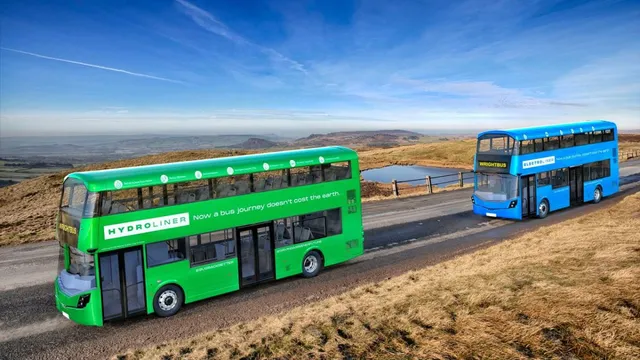
Wrightbus ramps up zero-emission bus production and hydrogen coach development
2025-04-10 23:01- Wrightbus will increase its production of zero-emission buses by 40% over the next two years.
- The company plans to hire hundreds of employees to support this production increase.
- The initiatives are part of a broader effort to enhance sustainable public transport in the UK.
Express your sentiment!
Insights
Wrightbus, a bus manufacturer based in Northern Ireland, is significantly enhancing its production capabilities in response to a growing demand for sustainable transportation solutions. The company announced its commitment to ramping up production by 40% over the next two years, which translates to the potential supply of up to 1,000 zero-emission vehicles to depots across the United Kingdom. This decision could lead to the recruitment of hundreds of new employees, demonstrating the company's investment in both its workforce and environmental initiatives. The envisioned increase in production reflects a broader trend in public transport sectors around the world, where governments and companies are looking to reduce carbon emissions and encourage the adoption of cleaner technologies. Wrightbus is particularly well-known for its innovative designs, including a modernized version of the Routemaster, previously ordered by Boris Johnson, the former mayor of London. By focusing on zero-emission vehicles, the company aligns itself with global sustainability goals. Additionally, Wrightbus has plans to invest £5 million in the development of the UK’s first long-distance hydrogen coach, which will have the capability to travel approximately 1,000 kilometers on a single charge of its fuel cells. This investment represents a significant leap in hydrogen technology for public transport, positioning Wrightbus as a pioneer in the shift towards hydrogen-driven transport solutions within the industry. Collectively, these initiatives highlight Wrightbus's dedication to overcoming the challenges of climate change and innovating in public transportation. The anticipated growth in zero-emission vehicle production, in conjunction with the development of hydrogen coaches, is not only expected to provide economic benefits through job creation but also contribute positively towards the goal of achieving a sustainable public transport system.
Contexts
The integration of zero-emission vehicles (ZEVs) into public transport systems is a transformative step towards achieving sustainable urban mobility. The reliance on conventional diesel and petrol vehicles has increasingly contributed to environmental degradation, including air pollution and greenhouse gas emissions. Transitioning to ZEVs, which include electric and hydrogen-powered buses and trains, offers a practical solution to mitigate these environmental impacts. By adopting ZEVs, cities not only improve air quality but also set the stage for a broader acceptance of sustainable transportation practices that can redefine urban landscapes. The switch to zero-emission technologies in public transport also aligns with various international agreements aimed at combating climate change, such as the Paris Agreement, further incentivizing municipalities to convert their fleets to cleaner options. Implementing ZEVs in public transit comes with distinct operational advantages, particularly in terms of cost efficiency and maintenance. Electric buses, for example, have significantly lower fuel costs compared to their diesel counterparts, attributed mainly to the lower cost of electricity versus diesel fuel. Additionally, ZEVs generally have fewer moving parts, which translates to reduced maintenance costs and improved reliability. Many jurisdictions have reported substantial savings when transitioning to electric buses, which not only lowers operational costs but also allows for redirected resources towards enhancing service quality and frequency. Moreover, innovative battery technologies are increasingly extending the range of electric buses, alleviating previous constraints related to distance and operational flexibility. The shift towards ZEVs in public transport systems can also drive economic opportunities and job creation within local communities. As cities invest in electric bus and charging infrastructure, new jobs emerge in manufacturing, installation, and maintenance sectors. Moreover, the development of a robust charging network lays the groundwork for future-market expansion into the electric vehicle sector, prompting collaborations with universities, tech companies, and local governments. This evolving industry not only creates immediate job opportunities but also cultivates a skilled workforce ready to meet the demands of an increasingly electrified transportation ecosystem. Additionally, the implementation of ZEVs can enhance public perception towards adopting cleaner modes of transportation, encouraging individual shifts to electric personal vehicles or even bicycles, thereby fostering a culture of sustainability. Despite the numerous advantages, integrating zero-emission vehicles into public transport is not without challenges. Initial capital costs for purchasing new ZEVs and establishing necessary infrastructure, such as charging stations, can be significant. However, various funding programs and incentives are available, including government grants and partnerships with private investors. Strategic planning and phased implementation can further mitigate these costs, allowing transit agencies to transition smoothly. Moreover, public engagement plays a crucial role in the acceptance of ZEVs—educating passengers about the benefits and addressing concerns over service reliability and range are essential steps in promoting a zero-emission future. As cities continue to adapt, the impact of zero-emission vehicles on public transport systems holds the promise not just to enhance urban transportation networks, but ultimately to contribute to the overall health and well-being of city residents.